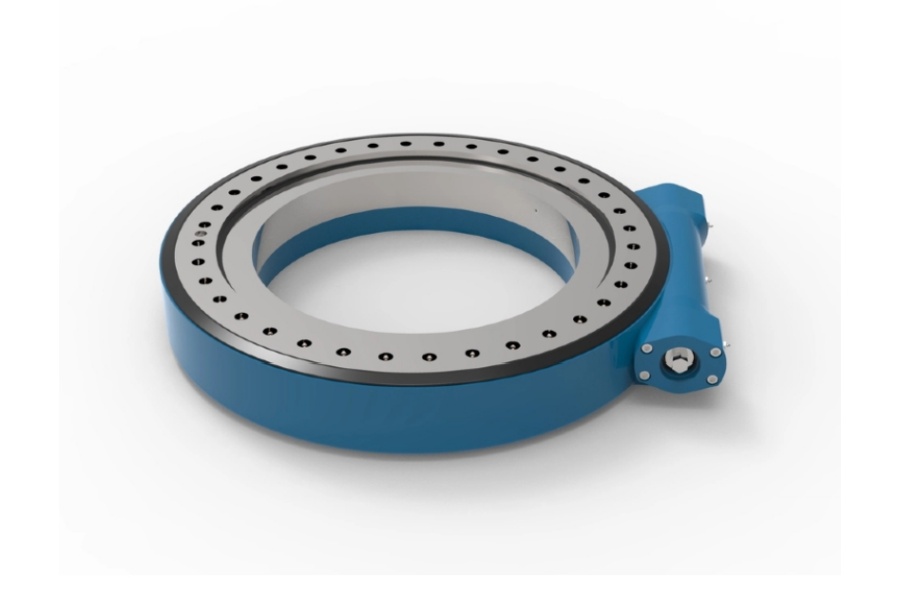
Five Essential Things You Need to Know About Slew Drives
What is a Slew Drive?
A Slew Drive (also commonly known as a slewing ring drive or slewing drive) is a highly integrated mechanical assembly designed to provide controlled rotational motion under significant load. At its heart, it combines a slewing bearing (a large-diameter bearing capable of handling axial, radial, and moment loads) with a precision gear reduction mechanism (typically worm gear, planetary gear, or spur gear) and often includes an integrated drive motor (electric or hydraulic) and housing. This compact unit transforms high-speed, low-torque motor input into low-speed, high-torque rotational output, enabling heavy structures to rotate smoothly and precisely about a single axis. Its primary function is to bear immense loads while delivering accurate positioning and reliable motion control.

Five Essential Things You Need to Know About Slew Drives
Understanding these core aspects is crucial for selecting, operating, and maintaining slew drives effectively:
Types of Slew Drives: Slew drives come in several fundamental configurations, primarily defined by their gearing and drive mechanisms. The most common types include:
Single Worm Gear Drive: Features one worm shaft engaging the gear ring (usually on the slewing bearing). Offers good efficiency, self-locking capability, and a compact design. Best suited for moderate loads and applications where self-locking is critical.
Double Worm Gear Drive: Utilizes two parallel worm shafts engaging a single gear ring. Provides superior load distribution, higher rigidity, enhanced moment capacity, inherent redundancy (if one worm fails, the other can often hold the load), and excellent backdrive resistance. Ideal for very heavy loads, high moment applications, and situations demanding high safety/redundancy (e.g., cranes, large solar trackers).
Planetary Gear Drive: Incorporates a planetary gear set for reduction before driving the slewing bearing ring. Offers very high reduction ratios in a compact space, high efficiency, and excellent torque density. Often used where space constraints exist alongside high torque requirements.
Spur Gear Drive: Uses spur gears for power transmission. Generally simpler but less compact than worm or planetary drives, often used in very large, lower-speed applications. The choice depends heavily on the specific load requirements (axial, radial, moment), required torque/speed, need for self-locking, redundancy, efficiency, and available space.
Core Function: Precision Rotation Under Heavy Load: The fundamental purpose of a slew drive is to enable controlled, precise rotation of substantial structures or equipment while supporting significant combined loads (axial, radial, and especially tilting moments). They excel in applications demanding:
High Torque Output: Transforming motor input into massive rotational force.
Accurate Positioning: Providing smooth motion with minimal backlash for precise angular control.
Robust Load Support: Handling the complex forces exerted by large, heavy components.
Reliability: Operating consistently under demanding conditions, often for extended periods with minimal maintenance. This unique combination makes them indispensable in fields like solar tracking (precisely aligning massive panels with the sun), crane operation (rotating booms and loads), and heavy machinery articulation.
Key Characteristics Defining Performance: Slew drives are engineered for demanding duty, characterized by:
Robustness & Durability: Constructed from high-strength materials (forged steel gears, hardened bearing races) to withstand heavy loads and harsh environments.
Smooth & Precise Operation: Precision machining of gears and bearings, combined with optimized preload and minimal backlash design, ensures controlled movement vital for accuracy.
Compact Power Density: Integrating the bearing, gearing, motor, and often brakes into a single unit saves significant space compared to traditional solutions.
Self-Locking Capability (Common in Worm Drives): The inherent friction angle in worm gears often prevents backdriving, safely holding loads in position without needing a separate brake (though brakes are frequently added for safety).
Configurability: Available with various drive options (electric motors - AC/DC, hydraulic motors), brake systems, sealing solutions (IP ratings for dust/water ingress protection), special coatings (corrosion resistance), and mounting interfaces. Open or enclosed housing designs cater to different environmental needs.
Wide-Ranging Industrial Applications: Slew drives are pivotal components across numerous industries where heavy loads need precise rotation:
Renewable Energy: Dominating solar tracking systems (single-axis and dual-axis trackers), rotating massive PV arrays. Used in wind turbine yaw systems (nacelle positioning) and pitch drives (blade angle adjustment).
Construction & Mining: Essential for crawler crane slewing superstructures, excavator attachment rotation (e.g., tiltrotators), drilling rig mast positioning, and heavy-duty material handling equipment.
Material Handling: Found in stacker-reclaimers, heavy-duty industrial turntables, rotating forklifts, and cable reelers.
Aerial Work Platforms & Vehicles: Powering rotation in cherry pickers, fire truck ladders/aerial platforms, and rotating utility vehicle equipment.
Precision Equipment: Enabling accurate positioning in radar antennas, satellite communication dishes, telescopes, sophisticated printing presses, and robotic welding positioners.
Industrial Machinery: Used in packaging machines, large machining centers (indexing tables), mixers, and 3D printing turntables.
Specifications and Maintenance Requirements: Selecting and maintaining a slew drive requires careful attention to key specifications and upkeep:
Critical Specifications:
Load Ratings: Dynamic & Static Axial Load, Dynamic Radial Load, Moment Load (Tilting Moment) - These define the fundamental capacity.
Torque: Drive output torque (related to motor power and gear ratio).
Gear Ratio: The ratio of input speed to output speed, determining output torque and speed.
Accuracy/Backlash: The amount of free movement between gear teeth, crucial for positioning precision.
Speed: Output rotational speed.
Weight & Dimensions: Physical size and mass of the unit.
IP Rating: Ingress protection level against dust and water.
Vital Maintenance Needs:
Lubrication: Using the correct type (grease - often EP2 or specialized high/low temp) and quantity of lubricant at specified intervals is paramount. Contaminated or degraded lubricant is a primary cause of wear and failure.
Seal Inspection & Replacement: Seals prevent contaminant ingress (dust, water, debris) and lubricant leakage. Regular inspection and timely replacement of worn or damaged seals are essential.
Mounting Surface Integrity & Bolt Torque: The mounting surface must be flat, rigid, and clean. Bolts must be tightened evenly and to the exact specified torque using a calibrated wrench, and re-torqued periodically as per the manufacturer's schedule to prevent loosening due to vibration. Improper mounting causes misalignment, premature bearing failure, and noise.
Regular Inspection: Visual checks for leaks, damage, and unusual noise/vibration help catch issues early.
Key Characteristics of Slew Drives
Beyond the "Five Things," several inherent characteristics define slew drives:
Integrated Design: Combining bearing, gearing, and often drive components into one compact, pre-assembled unit simplifies installation and improves reliability.
High Load Capacity: Specifically engineered to handle complex, multi-directional loads simultaneously, particularly large overturning moments.
High Stiffness/Rigidity: Minimizes deflection under load, crucial for maintaining precision.
Versatility: Available in various sizes, configurations, gear types, drive options, and with numerous accessories to suit a vast array of applications.
Efficiency: Modern designs, especially planetary and optimized worm drives, offer good mechanical efficiency for the torque delivered.
Safety Features: Options like integrated holding brakes and the inherent self-locking of worm gears enhance operational safety.
Factors Influencing Slew Drive Pricing
The cost of a slew drive varies significantly based on numerous engineering and commercial factors:
Size and Load Capacity: The physical dimensions (primarily the slewing bearing diameter) and required load ratings (axial, radial, moment) are fundamental cost drivers. Larger, higher-capacity drives require more material and complex manufacturing.
Gear Type and Precision: Double worm drives are typically more expensive than single worm drives due to complexity. Planetary drives can vary significantly based on precision and ratio. Higher gear quality (AGMA/DIN class), surface finish, and heat treatment increase cost but enhance performance and longevity.
Slewing Bearing Specifications: The type (ball, roller, crossed roller), size, internal clearance/preload, raceway hardness, seal type, and overall quality of the integrated bearing are major cost components.
Drive Motor and Accessories: The cost of the integrated motor (electric AC/DC or hydraulic), its power rating, and any additional accessories like brakes (type and size), encoders, sensors, or special connectors significantly impact the total price.
Materials and Manufacturing: The grade of steel for gears, worms, housings, and bearing components, along with any special coatings (corrosion protection, wear resistance), heat treatments, and the precision of machining processes affect cost. Cast vs. machined housings also influence price.
Sealing and Environmental Protection: Achieving high IP ratings (e.g., IP65, IP67) requires sophisticated sealing systems and design, adding to the cost. Special seals for extreme temperatures or chemical resistance also increase price.
Customization: Standard catalog drives are generally more economical. Customizations – unique mounting flanges, special shaft configurations, non-standard gear ratios, specific material grades, or special testing requirements – involve additional engineering and manufacturing costs.
Brand Reputation and Quality Assurance: Established manufacturers with rigorous quality control (ISO certifications), extensive testing, proven reliability records, and strong technical support typically command a premium over lesser-known or lower-tier suppliers.
Order Volume: Economies of scale apply; larger orders usually result in lower per-unit costs.
Supplier of Slew Drives
LYRADRIVE is a recognized manufacturer specializing in the engineering and production of robust, high-performance slew drives for demanding industrial applications. They offer a range of solutions, including reliable single and double worm gear configurations, designed to handle significant axial, radial, and moment loads. LYRADRIVE focuses on quality materials, precision manufacturing processes, and rigorous testing to ensure durability and long service life in challenging environments like solar tracking, construction machinery, and material handling. Their expertise provides application-specific support for selecting and implementing the optimal slew drive solution. For detailed specifications and technical assistance, consulting directly with LYRADRIVE is recommended.



